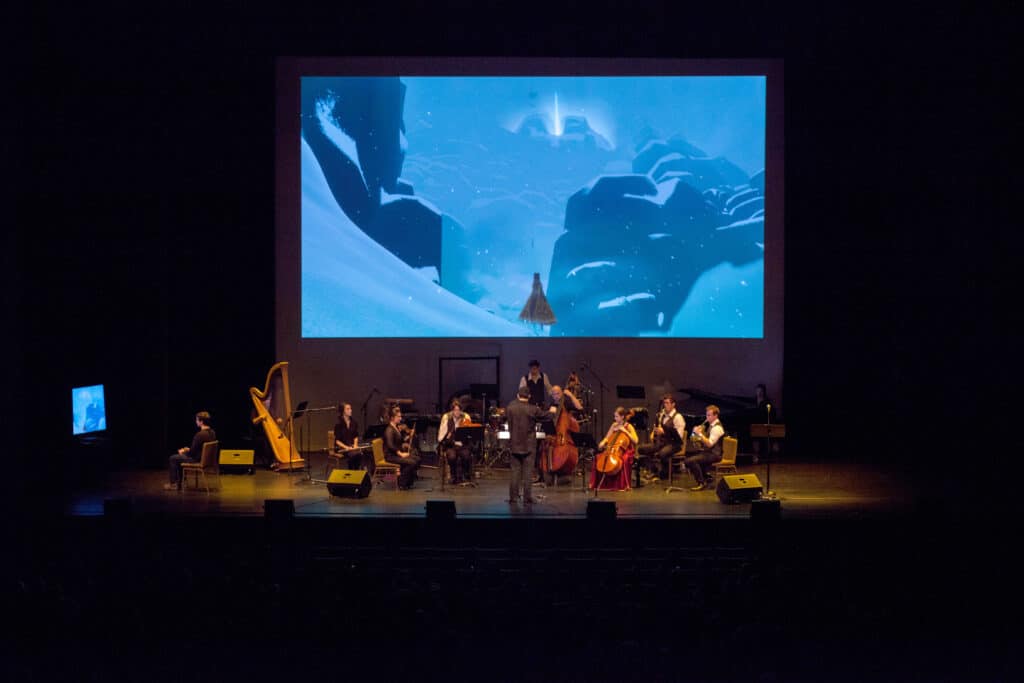Turning the Tide
To reach millennial audiences, arts organizations must adapt to a new set of tastes, technologies, and spending habits. New data from the Wallace Foundation can help.

First, the bad news (if it’s even news at all): Today’s young adults—the so-called millennial generation—are attending arts performances at a lower rate than previous generations at their age. This widely-observed trend is the latest subject of inquiry for the Wallace Foundation’s Building Audiences for Sustainability (BAS) initiative, a six-year effort to study and share prospects and strategies for the financial future of the arts. Many arts organizations have experimented with new approaches to attracting this new, ascendant generation of listeners; others have written them off altogether. The Wallace Foundation is focused on helping arts organizations by discovering and sharing the best strategies for turning them into patrons and supporters for life.
Founded in its current formation in 2003, the Wallace Foundation has an established history exploring challenges and issues in education, and has since made a commitment to sharing its insights on the changing dynamics in performance and arts institutions. The foundation’s work has focused partly on granting the Wallace Excellence Awards, which provide support for research and experimental projects for local arts organizations whose discoveries and learnings can be shared to the wider community, and partly in the group’s studies of industry and audience trends, which includes the BAS initiative.
Arts organizations come in all shapes, sizes, and locations. While the Wallace Foundation’s grants have often gone to larger institutions—San Francisco Performances and Chicago’s Steppenwolf Theatre, to name two—the objective of the BAS initiative is to expose the wider community to the results and recommendations it supports at institutions of diverse audiences, sizes, disciplines, histories, and ages.
Age diversity, as it happens, is the focus of the study’s latest release: After previous installments with broader topics like “Finding and Keeping Your Audience”, the Wallace Foundation has trained its focus on how the millennial generation’s interests, values, expectations, and concerns differ from those of prior generations. The study collected information about these listeners, currently between the ages 18 and 34, by partnering with a variety of arts organizations to communicate with current, past, and potential patrons.
We led with the bad news, so here comes the good: thanks to the BAS study, we now have a wealth of concrete, arts-specific information to help devise strategies to attract millennials’ patronage for now and years to come. By understanding better the unique finances, preconceptions, and preferences of these prospective patrons, arts organizations can begin to turn the tide and build for this new and rising audience of listeners as they encounter the arts as adults.
The Anatomy of a Millennial Listener
To understand shrinking millennial participation in the performing arts, the BAS initiative first focused on the generation’s unique socioeconomic condition. According to the study, millennials “face more financial challenges than prior generations; many may never catch up, creating a permanently more difficult environment for arts organizations.” This financial trend exists in many realms of millennial life: As a bloc, millennials earn 8% less annual income, carry 43% less in net worth, hold 77% more loans, and have 60% more student debt, as compared to their counterparts in 1990.
As a result, financial concerns suffuse a price-consciousness and parsimony that is ubiquitous throughout the BAS study’s findings of the generation’s purchasing attitudes. Because finances are tight and expectations are different, millennials tend to be anxious and conservative with purchasing decisions. Consumer habits and lifestyle choices distinguish the group: Millennials are, on average, significantly less likely to own or be interested in owning a car, and, as we’ll examine later, tend to closely scrutinize investments they don’t feel confident they’ll enjoy.
Millennials’ ethnic and political profiles are also significantly different from other generations—43% of the group is non-white, the highest share of any generation in American history, and they skew more politically liberal than their predecessors. Perhaps relatedly, Millennials place an especially high value on diversity itself, favoring a broad definition of the term that encompasses manifold differences within people spanning religion, language, geography, nationality, sexual orientation, and interests. They are less diverse in their living aspirations, however: Millennials exhibit historically high interest in living in cities, almost 9% more than the previous generation and 15% more than the generation before. They’re also largely “on the move”: Millennials overwhelmingly expect to move to a new residence or city in next five years.
It’s worth mentioning that the drop in millennial arts attendance, while profound, is actually less significant than that of other age cohorts over the same period. While attendance has diminished across all age demographics in recent years, 35 to 49 year olds—known as Generation X—have declined in attendance at an even greater rate for ballet, classical music, and opera performances, despite comparatively greater spending power. Could this suggest that millennials might be more easily reclaimed by arts organizations?
Millennial Audiences: Concerns and Preferences
To answer this question, the Wallace Foundation identified “inclined” individuals—current, former, and prospective patrons of various arts organizations across the country—and conducted research to bring their perceptions into greater clarity. (Methodologies defining “inclined” individuals differed among studies; some required actual attendance at similar events; others accepted interest in attending events or simply general interest in the category.)
Across these studies, respondents identified several key barriers to purchase and attendance decision-making that correspond to their pronounced financial concerns, social habits, and lifestyle preferences. These include: Cost, not having friends to attend events with, being busy with other things, and limited knowledge and awareness of arts organizations. Critically, these barriers persisted among current, past, and prospective millennial arts patrons, regardless of the size, location, or type of programming at reporting arts institutions.
Cost, chief among millennial considerations, encompassed related concerns, like paying for an experience that runs the risk of not being enjoyable, failing to get decent seats, or encountering the wider costs of having a special night out. Millennials appear to be uniquely value-conscious in their buying habits, and “are willing to spend more freely for rock concerts or other special events they know they’ll enjoy”.
These financial concerns not only made interested patrons less willing to check out performances they felt they might not enjoy, it also skewed their perception about the potential cost of tickets. On average, millennials estimated the cost of performing arts performances to be more than twice their actual average prices, which also happened to be significantly higher than estimates from members of the Generation X and Baby Boomer age cohorts.
Beyond the group’s price concerns, the BAS study also focused on the generation’s significant (and well-documented) relationship with digital media and technology. Millennials are “digital natives”—they grew up with the internet and cellphones, and have become accustomed to accessing much of their interests and entertainment through these mediums. 90% of millennial respondents reported use of social media sites, significantly more than any other generational group. 73% said they check their phone several times an hour, with 22% checking every few minutes. A whopping 87% said their phone never leaves their side, night or day.
Unsurprisingly, many of the Wallace Foundation’s findings point to millennials’ interest in experiencing the arts as shareable, social content: Current and inclined patrons widely reported their desire to attend events with friends, dates, and colleagues, as well as their interest in broadcasting their experiences on social media. 55% of respondents agreed that “[b]eing able to socialize with friends is an important part of the performing arts experience,” and agreed that some events would be best enjoyed with a whole group of friends, rather than alone or with just one companion.
But when asked about their interest in socializing at various arts events, many millennials reported significant reservations. Many respondents couldn’t imagine how to get their friends to go with them to the orchestra, dance, or opera, for example. This widely reported phenomenon proved to be a key barrier, irrespective the organization’s discipline or size.
Millennials, as a group, also perceive themselves as being very busy, to the point of being overburdened by their day-to-day obligations. In considering the free time they do have, they named a broad slate of activities and expenditures that compete for their attention, money, and time. Not only do millennials consider other options within the performing arts space (such as seeing other live music, comedy, and theatre), the group also saw eating out at restaurants as a compelling alternative.
Strategies for Success
Taking Millennials’ specific concerns and values in hand, the researchers were curious to identify elements to have successfully attracted the group to arts performances.
Unsurprisingly given how price-consciousness noted above, the BAS study found clear communication around pricing to be an essential part of successful arts marketing efforts. Similarly important were the outlets and media the arts organizations used to share such information. Millennials were found to encounter information about arts events predominantly by word of mouth, from family or friends, and on social media (particularly Facebook and Instagram). Email campaigns—conducive to forwarding, and more personal in effect—were likewise often effective.
Given the group’s attentions, traditional forms of media, such as TV, radio, newspapers, and magazines, rank in the middle or near the bottom of their discovery sources. If you want to get in front of millennials, the study suggests, don’t start with newspaper ads. Accounts and ads run on Instagram, Snapchat, Facebook, Twitter, and other social networks can reach this audience where they’re looking. Similarly, organically obtaining email lists for prospective and current patrons proved highly useful, particularly if the content of the email is interesting and useful—otherwise it may be seen as “spam” and quickly ignored. Partnering with other organizations is a reliable way to get access to new email lists, as well as collecting contact information and encouraging current patrons to forward emails or ask friends to look your organization up on social networks.
Predictably, millennials who attend arts performances report many secondary benefits from the experience that can be widely emphasized in event promotion. Many respondents attested to emotional and spiritual benefits—witnessing the arts helped them feel alive, present, and part of something bigger, and enhanced their sense of self. It also helped the group escape their day-to-day stress. Millennials also responded positively to programs that contained themes that helped them see more meaning in their day-to-day lives, and those that related to the group’s dominantly progressive values.
Of course, millennials, like generations before them, are not a homogenous entity, and the BAS study revealed fractured preferences within. To help tease out these subgroups, the Wallace Foundation identifies four sets of concerns with different weight for different segments of the population, including: “Vibe”, What the atmosphere of a place or venue feels like; “Buzz”, a feeling of excitement and fun; “Buzz-worthy”, likely to arouse interest or attention; and “Fit”, whether an event feels right for a given individual. These dimensions are instructive to planning and marketing events that appeal to particular groups.
In other words, it’s not necessarily enough to know that you want to target millennials as a bloc. For example, while a segment of the age group strongly valued cultural events as opportunities to dress up and build an evening around, others saw this as prohibitively stuffy and wanted events with no formality or dress code. Knowing your prospective audiences is key.
The study explored, in particular, Millennials’ preference for “buzzworthiness”—to what extent can Millennials share the event with friends, both on and offline? This quality can be achieved by helping appeal to the group’s desire to socialize: Is it an experience they’d like to recount? Does it feel shareable and relatable? This, too played into the “vibe,” or environs, of a performance: Are attendees surrounded by other audience members they feel they “fit” with, and are of their own age? Are there drinks and food available? Does the event provide access to performers themselves, feel cool, or take place in a special or destination venue they can get excited about?
This last point was everywhere in the study. Millennials attend arts performances in part aspirationally: They go to achieve personal growth, to trigger emotion and have valuable experiences, to personally and politically relate to and engage with the themes in presented works, and often to talk about how the arts make them feel. What does an event offer that these viewers can use to communicate something about themselves to their friends in live conversations, and to followers across social media? How does it represent them?
Millennials appreciate the value of attending performing arts performances, so reaching potential young patrons where they are, and in the terms that matter to them, is important. This can seem a daunting problem, and indeed there is no panacea: Every community is different, and the BAS initiative notes that their suggestions are dependent on the content of arts offerings, as well as the “fit” for any particular arts group. That said, they noted value in expressing the adventurousness and uniqueness of live performance, the opportunities to connect with friends and family in a unique and different way, and the chance to access new communities. To tap into these areas, they recommend emphasizing the topics and social values of the exhibited work, as well as the diversity and perspectives of the presenting organizations, performers, and artists themselves.
Audiences are constantly changing, and organizations of any discipline must remain in a state of becoming to continue to bring the beauty and vitality of art to viewers, regardless of who they are, into the future. While millennial audiences are no different in their newness, they are also no different in their knowability. By understanding the group’s concerns, interests, and desires, arts performances can be welcoming places for this new, ascendant generation. If your organization focuses on your audience, there will always be good news.
Millenials
Quick Stats
Millennials have less disposable income than previous generations. They earn 8% less annual income, have 43% less in net worth, hold 77% more loans, and carry 60% more student debt.
Millennials are more diverse (43% non-white) than previous generations.
They express a higher preference for living in urban areas.
Millennials encounter information about the arts predominantly via word of mouth, from family or friends, and on social media.
Barriers to Attendance
Cost: Millennials closely scrutinize their spending decisions.
Busyness: Millennials perceive themselves to be exceedingly busy.
Awareness: Millennials often don’t know about the arts offerings in their communities.
Atmosphere: Millennials report having trouble convincing their friends to attend arts events with them.
What do they want?
Millennials want social experiences. They want to be able to share their artistic experiences with friends, both online and off.
Some enjoy getting dressed up. Others find it stuffy and intimidating.
Millennials attend art events aspirationally. They want to experience personal growth, to relate politically and personally to the performance, and to talk about how it makes them feel.


